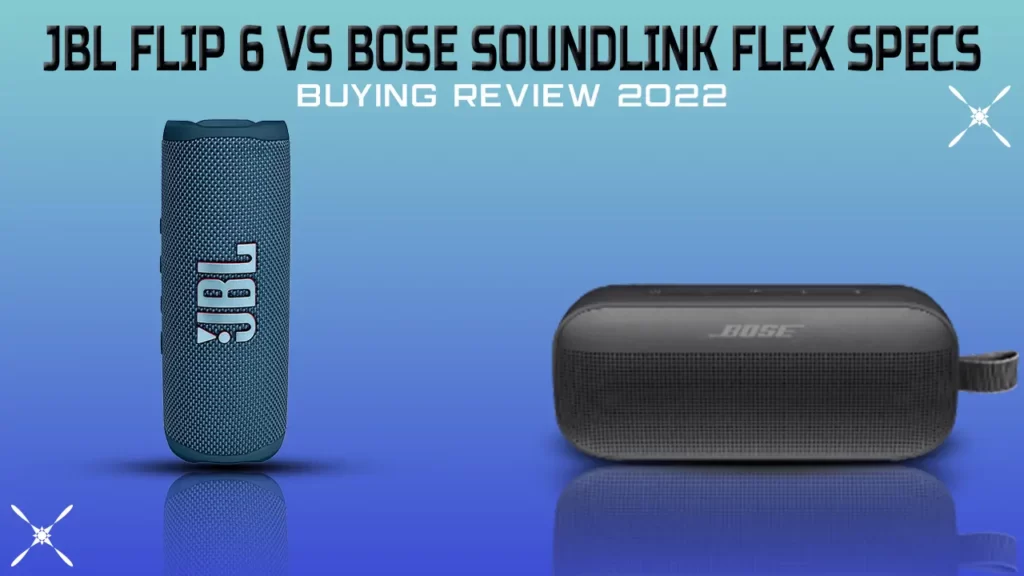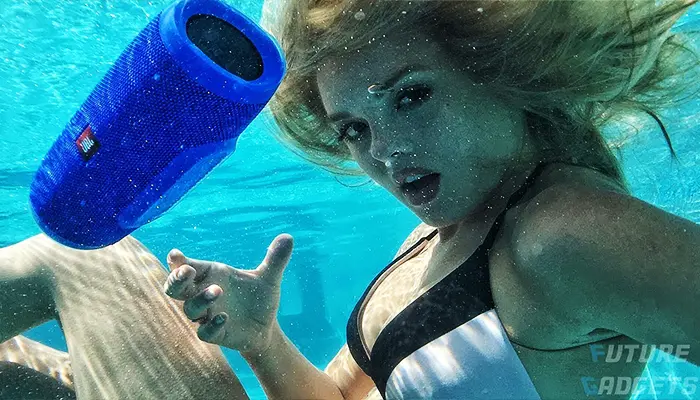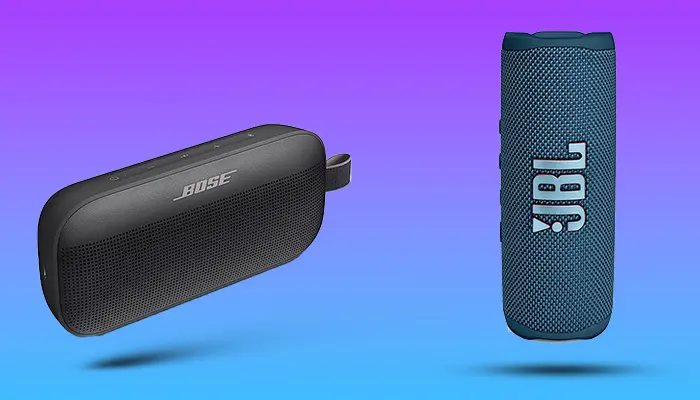Both JBL Flip 6 and the Bose Soundlink Flex are portable yet powerful speakers. They can handle your beach trips or house parties with ease. Both of them are head-turners in the price range. In this JBL Flip 6 vs Bose Soundlink Flex buying guide, we present a head-to-head comparison between these speakers’ specs.

| Specifications | JBL Flip 6 | Bose Soundlink Flex |
|---|---|---|
| Dimensions(hwd) | 6.8cm x 17.8cm x 7.2cm | 20.1cm x 9cm x 5.2cm |
| Weight(lbs) | 1.21 | 1.3 |
| Material | Fabric jacket on the circular surface Rubber material on the edges and ports area | Silicone back Steel powder-coated grille |
| Water Proof | Yes(IP67) | Yes(IP67) |
| Dust Proof | Yes(IP67) | Yes(IP67) |
| Color options | Dusty Pink Grey Stone River Teal Fiesta Red Ocean Blue Midnight Black Steel White Forest Green Squad | White Stone Black Stone Blue Crimson Red(LE) |
| Battery backup (hours) | 12 | 12 |
| Charging time (hours) | 2.5 | 4 |
| Charging cable | USB-C | USB-C |
| Output power(Watt) | 30 | N/A |
| Internal Drives | 1 x 16mm tweeter (10W) 1 x (45 x 80)mm driver(20W) 2x passive radiators | 1 x 60mm driver 2 x 76.2mm passive radiators |
| Speaker sound channel configuration | N/A | 2.1 |
| Auxiliary input/Output | Not included | No included |
| Microphones | Not included | Included |
| Sound Quality | Better Mid and High | Better Bass |
| Bluetooth version | 5.1 | 4.2 |
| Bluetooth range | 40 meters approx. | 9 meters approx. |
| Bluetooth multipoint support | Yes, up to 2 devices | No |
| Audio Codec Support | SBC Only | SBC only |
| Application Support | JBL Portable app | Bose Connect app |
| Advance Technology | N/A | PositionIQ Technology |
| More extra features | Physical Battery Indicator, JBL PartyBoost | Party Mode |
| Check Price | JBL Flip 6 | Bose Soundlink Flex |
Build Quality
Both the speakers are pretty sturdy in hand. Playing around with them was fun. The Fabric strap on both of them is very tough, absolutely not to worry about falling down. Though if it falls you are well protected. We also tried a drop test with the speaker and I have to say both are solid. The Flip 6 has retained some damage on the rubber edges but the surface fabric is all good. Unlike Flip 6, the Soundlink Flex has not retained any damage marks.

The Soundlink Flex has a rectangular brick design which makes it easy to stand on pretty much any surface. Bose even claims that they have made the speakers floatable. The internal structure of the Soundlink Flex acts as a buoyant body and does not sink to the surface. The Flip 6 on the other hand has a tubular shape and can roll over if not placed on a flat surface. This is a bit disturbing sometimes. We were getting irritated when we kept the Flip 6 on our car dashboard and it constantly rolled after a slight jerking.

IP67 is included with both of them, so along with water resistance, you also get dust resistance. While the dust won’t harm your device but it can bother you if you are using the Bose Soundlink Flex. The latter has a steel grille design because of which if dust enters the grille you might hear them rattling inside. Well, this is just an assumption, we did not experience anything like this during our test.
The buttons on the Flip 6 were better and gave a premium look. I was able to distinguish them easily after using them for some time. This is unfortunately not the case with the Soundlink Flex. Both speakers are fairly easy to carry around because of their build size and weight. You have numerous color options to choose from in both speakers. But the Soundlink Flex beats in this regard as it has a more premium build quality, more sturdiness, and a better strap-on. The Flip 6 is better in terms of look and feel.
Battery and Power
In the battery department, both speakers are again the same. Both have the same 12 hours of battery life if used in 50% – 60% volume. Though the JBL Flip 6 beats the Bose Soundlink flex in terms of charging time, where the Flip 6 charges in 2.5 hours as compared to 4 hours on the Soundlink flex.

Both headphones support USB-C ports. USB-C to USB-A type charging cable is present in the box in both of the speakers. In terms of Output wattage, we get 30W from Flip 6. Bose hasn’t mentioned any significant Wattage of their speaker and no other third party has noted it either.
In this section, the Flip 6 is better because of its fast charging capability which is quite noticeable. If you are not concerned with fast charging then in this section both speakers have absolutely no differences.
Sound Output
The JBL Flip 6 and Bose Soundlink Flex both have quite nice audio quality. We tested both of them with the same environment settings and the same music. You will not be able to notice any significant differences in music just the bass will seem quite punchier on the Sounlink Flex. Despite this, everything else is quite the same. Well, the JBL Portable app along with the Flip 6 can make many differences, more on that later.
The Bose Soundlink Flex is equipped with a 60mm circular driver and dual passive radiators. The passive radiators are in the front and back and are responsible for thumping bass effects. Passive radiators are a clever way of enhancing the volume and sound quality. They operate on the air resonance from the driver rather than operating on electricity.
The JBL Flip 6 is equipped with a 45mm x 80mm rectangular driver and a 16mm tweeter. The tweeter is a new addition to the Flip series. The Flip 5 lacked this extra speaker. It also contains dual passive radiators like the Soundlink Flex. The passive radiators here are mounted on either side of the speakers and these give a cool look to the speakers when they vibrate.
The speaker configuration on the Soundlink Flex is 2.1 based but JBL has not mentioned any such specification. Both of the speakers also lag an auxiliary port. The inclusion of the port would make them an all-rounder but with the increasing wireless technology, it would be very rare for someone to use an aux port.
You will be amazed to hear, the Soundlink Flex unlike the Flip 6 has a microphone for calling and voice controlling. Voice assistants such as Alexa, Siri, and Google Assistant are supported by the speaker and you can easily control all audio settings with your voice. We tested the mic and it was decent.
Coming over to the sound quality, the JBL Flip 6 has a more balanced sound than the Bose Soundlink Flex. The latter has punchier bass and will be favorable for bass lovers. But, personally, I loved the sound of Flip 6. You can also get a punchier bass on the Flip 6 with the help of the JBL portable app. I will tell you about that in the Extra features section.
Summing up, according to the Sound quality I would prefer the JBL Flip 6 over the Bose Soundlink Flex because of the more balanced sound output. I am not someone who will be controlling the music with my voice and also attend calls on the speaker rather than on the phone. For me, the microphone isn’t a big advantage but the sound quality is for sure.
Connectivity
In terms of connectivity, the JBL Flip 6 has 5.1 Bluetooth support whereas the Bose Soundlink Flex has 4.2 Bluetooth support. The 4.2 version is an earlier version and offers a significantly low range than the 5.1 version. We tested both the speakers on an open field and the JBL Flip 6 was going well even after 30 meters, while the Soundlink Flex was only running well up to a mere 10 meters.
Also, with the increase in the version, the Flip 6 allows you to connect two devices simultaneously and the speaker will change controls between both devices automatically. In the case of Soundlink Flex, the speaker will connect to two devices but you have to switch controls between the devices manually.
Both of the speakers don’t have any advanced audio codec support. They only support the SBC codec, which is the most common codec found in every Bluetooth device. Of course, you will notice delays when playing any online game and we experienced it too. But, video and music streaming are all perfect.
In this section, Flip 6 is a clear winner. It has a newer Bluetooth version, more distance coverage, and Bluetooth multipoint support.
Extra Features
Both JBL and Bose provide extra features with nearly all of their products and these aren’t any exceptions. The JBL Flip 6 supports JBL Protable app. This app is helpful because it has a battery indicator. The app also has an inbuilt Equalizer which you can use to control the Bass, Mid, and Treble. This equalizer provides noticeable differences in the sound profile and we loved it. Also, the app allows you to upgrade your speakers if the company pushes any newer firmware version.
The Bose Soundlink Flex also has a Bose Connect app but unlike the JBL portable app, you cannot use any Equalizer here. The app provides firmware support and an audio feedback button. I kept the feedback button off because I don’t like the cheap-sounding person saying that my device is ready to connect to Bluetooth. For Equalizing though you can use any third-party application.
The Bose does have a pretty nice inclusion of PositionIQ Technology, which according to Bose will enable the speaker to provide you with the same quality of music despite the device’s orientation. This feature does work and we kept the speaker on different angles and noticed the difference.
Moving on, we also have a Party Mode on the Bose Soundlink Flex that lets you connect two Bose devices and play the same music simultaneously, though they need to support the Party Mode. JBL has a similar but better technology – PartyBoost. This enables up to 100 JBL devices to connect to each other and play the same music simultaneously.
We also need to mention, the Flip 6 also has a physical battery indicator on the speaker as well. This enables you to know how much juice is left over without turning on the JBL Portable app.
JBL Flip 6 vs Bose Soundlink Flex – The Verdict
Both the devices are pretty similar with some differences. The JBL Flip 6 has a more premium look and feel with a tubular design whereas the Bose Soundlink Flex has sturdier and has a premium steel grille build. The Flip 6 charges much faster than the Sondlink Flex. The Soundlink Flex has a microphone and offers more bass levels as compared to the balanced sound quality in Flip 6. The Flip 6 is better in terms of connectivity. The Bose Soundlink Flex on the other hand has more extra features.
| Specifications | JBL Flip 6 | Bose Soundlink Flex |
|---|---|---|
| Build | ❌ | ✅ |
| Battery and Power | ✅ | ❌ |
| Sound Output | ✅ | ❌ |
| Connectivity | ✅ | ❌ |
| Extra Features | ✅ | ❌ |
Beatmentors recommend JBL Flip 6
The Flip 6 is the clear winner and provides more value at a lesser price point. The Balanced Sound Output, better Bluetooth range, Bluetooth multipoint, JBL Portable app, and PartyBoost technology make the JBL Flip 6 the clear winner.
FAQs
How long does Bose Flex last?
The Bose Flex can stay up to 12 hours without charge if music is played at 50% to 60% volume. Realistically it stays up to 10 hours on 50% volume and up to 6 hours on 90% volume.
Can you use Bose Soundlinke Flex in the shower?
You can of course use them as they are IP67 water resistant and can stay up to 30 minutes in 1 meter under water.
Is the JBL Flip 6 loud?
The Flip 6 is loud as it now contains an extra tweeter compared to the earlier Flip 5. You will be able to use it at a beach party or a small gathering.